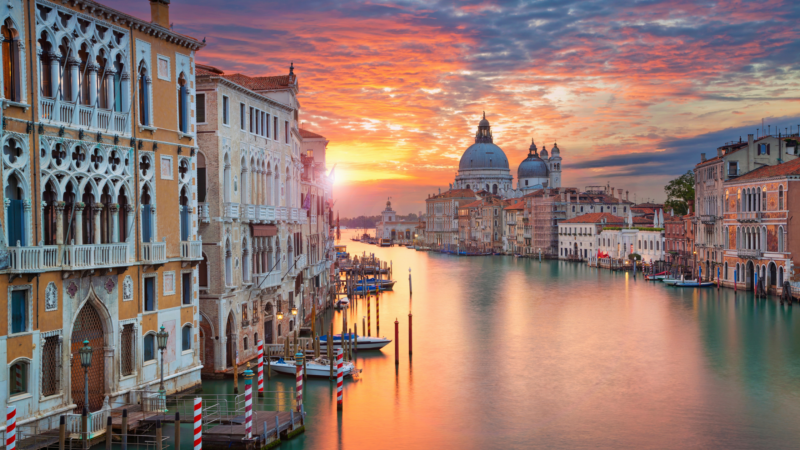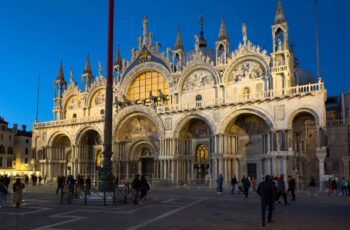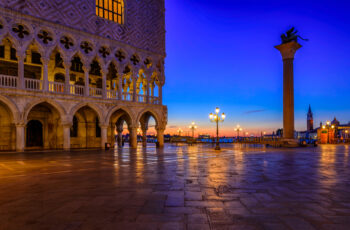Millions of visitors flood to Venice each year to marvel at her beauty. But as the devastating effects of overtourism and climate change become harder to ignore, we look at how Venice was built, why she is in danger and whether we can do anything to stop it from sinking.
Why did people move to Venice?
When the Roman Empire collapsed in the 5th century A.D., Italy was no longer a safe place to live. Without a strong military, barbarian tribes from Germany and Eastern Europe were free to invade Italy. In fear, people fled their homes on the mainland for the seclusion of the lagoon. They used the marshy lagoon for protection and found refuge among the poor fishermen living there. As the invasions continued across Italy, more refugees joined the first settlers and the need to build a city grew. According to legend, Venice was founded at noon on Friday March 25th 421 AD close to the Rialto Bridge (and has just celebrated its 1600th birthday!).
“To build a city where it is impossible to build a city is madness in itself, but to build there one of the most elegant and grandest of cities is the madness of genius.”
– Alexander Herzen
How was Venice built?
How Venice was built is perhaps its most fascinating story. When the new settlers arrived on the island, they had to find ways to drain and strengthen the land. They did this by digging hundreds of canals and using wood pilings to keep the banks in place.
There wasn’t enough land for all the houses they needed, so they had to find a way to make marshy areas strong enough to build on. To do this they outlined areas in clay, then filled them with soil from the lagoon. Once this had dried out, they added more soil to protect the land from the tide. But eventually the residents of Venice wanted stronger stone housing which was going to need stronger foundations.
Around the Lagoon, there were forests which were perfect for making large numbers of flat-topped piles. These were driven into the caranto, the sedimentary clay beneath the Lagoon, and the spaces between packed with small stones and sand to keep them from moving. Over time, the wood, deprived of oxygen and absorbing silt from the surrounding water, hardened and created an artificial bedrock. On top of the posts, planks of wood were used to create a level platform, known as a zatterone, and the palaces of Venice were built on top.

This technique was used to build bridges as well as houses. Under the Rialto Bridge there are an incredible 12,000 3.5m-long piles, keeping this iconic symbol in place.
Is Venice really sinking?
Sadly, yes, it is. Although the wooden piles have been holding Venice up for centuries, the city is slowly sinking into the Mediterranean. Today, some people see Venice as the sinking city rather than the floating city. UNESCO closely monitors the constant danger to the city. In 2021 Venice narrowly avoided (and not for the first time) being added to the list of endangered heritage sites when the authorities decided to ban large cruise ships from entering the city.
But this isn’t a new phenomena, Venice began sinking the moment it was built. The weight of the city pushes down on the mud beneath it, squeezing out water and compacting the soil. The result? The city today is an incredible 72 inches (183cm) lower than it was in 421 AD.

Each year, Venice sinks another 1-2mm. This, together with high tides (locally known as acqua alta) and erosion in the Lagoon, causes periodic flooding in the city. Over the past century, the city has sunk 9in (23cm) while global warming has increased the number of flood days. If the situation doesn’t improve, experts predicts that rising sea levels could cover Venice by 2100.
Can we do anything to save Venice?
After almost 20 years of work, the MOSES flood barrier at the entrance to the Lagoon became operational in 2020. During high tides, the barriers temporarily close the Lagoon to prevent sea water from entering. While the barrier has had some success reducing flooding in the city, the project has had many problems due to corruption and concerns from environmental groups about the impact on the delicate ecosystem of the Lagoon.
Overtourism is a more difficult problem to deal with. Despite struggling with vast visitor numbers before the pandemic, the 2020 lockdown proved just how dependant Venice is on tourism. To try and improve the situation for visitors and residents, the city is encouraging more responsible tourism practices. Famously strict rules already limit what visitors can and can’t do in the city and from 2022, day trippers will have to pay an entrance fee.
Luckily, following the rules is also the best way to truly experience Venice. Plan on staying for several days in a locally owned hotel, eat seasonal dishes in local restaurants, avoid illegal street vendors and mass produced souvenirs. Don’t limit yourself to St. Mark’s and the Grand Canal. Visit the quieter neighborhoods and see what life is really like in a city where even the Amazon courier arrives by boat!







